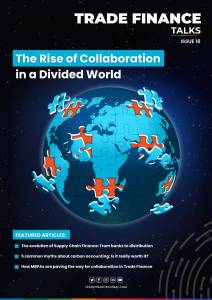Estimated reading time: 4 minutes
Over the past several months, corporates have increasingly been asking for details on a bank’s distribution capabilities when deciding which financial firm to work with.
Although receivables and payables financing provides an alternative source of liquidity to companies while allowing them to improve their cash flow metrics, sometimes these programs can vary greatly in size –anywhere from $10 million to $10 billion.
When the programmes become that large and no single bank has the credit lines to support them, distribution becomes a valuable tool.
Distribution provides several benefits for participating banks and corporations. Distribution of supply chain finance (SCF) and working capital assets allows one bank to lead a program and work with other banks as participating lenders in the program.
Additionally, distribution allows banks to lead a large programme that may exceed available limits, collect fees from distribution, and enhance returns on a programme.
For the corporates, the benefits include having one point-of-contact bank to interact with on the programme regarding documentation or questions, using distribution to share wallet share with their bank group, and having the ability to remove or add banks as the programme size changes.
Evolution of the SCF investor base
When distribution strategies first appeared in the early 2000s, the investor base was only banks. Over time, asset managers, hedge funds, insurance companies, and other non-bank entities started to look at the supply chain as an asset class and invest in these programmes.
Currently, the market has bifurcated into the bank and non-bank market segments with minimal overlap. Typically, banks are more interested in investment grade corporates, and the non-banks have been more interested in the higher yielding non-investment grade options.
In the last three to five years, more non-banks have entered SCF and the working capital market.
These asset managers and hedge funds typically source their deals from financial technology (fintech) firms, banks, or directly from lower-rated corporates.
Historically the operational intensity associated with purchasing and managing a large number of invoices kept non-banks out of the market, but fintechs have started to provide technology that allows non-banks to effectively monitor and manage a large number of invoices.
Why the sudden interest in supply chain finance?
The popularity of SCF programmes among investors started to rise in tandem with global interest rates, driven by the fact that these are short-term, uncommitted, self-liquidating assets that allow an investor to ride the rise in rates.
Ten years ago, there were almost no non-bank investors interested in SCF. Today, some of the largest asset managers, insurance companies, and hedge funds have funds dedicated to SCF and working capital assets.
In addition to the aforementioned benefits, the rise of technology to accommodate operational needs, and the historically low default rates within SCF have contributed to the asset class’s popularity. As the market becomes more transparent, standardised, and easier to access, we expect the investor base to grow along with increased adoption by a diverse group of corporations.
The future of SCF distribution
We see several factors that will impact the future of the SCF market.
The Financial Accounting Standards Board’s (FASB) new supplier finance regulations will require that companies disclose if they have a SCF programme in place.
The effect of this increased transparency is still to be determined, however more corporations may implement SCF programmes because they will now have visibility into their competitors that have already implemented them.
Secondly, banks that sell a significant amount of SCF are using similar participation agreements and distribution processes. This will make it easier for investors to sign up and buy from several different banks.
Lastly, more innovative legal structures – such as Irrevocable Payment Undertaking (IPU) and Drafts (i.e. Bills of Exchange) – are making it easier and more efficient to originate SCF programs in various jurisdictions.
A catalyst for growth for the distribution and origination of SCF will be more standardisation and transparency. Banks that have experienced and dedicated distribution teams will be able to capitalise on the growth of the market and be in a position to influence the development of the investor market.















































